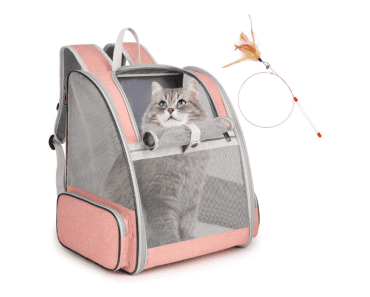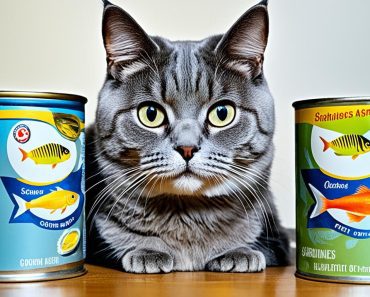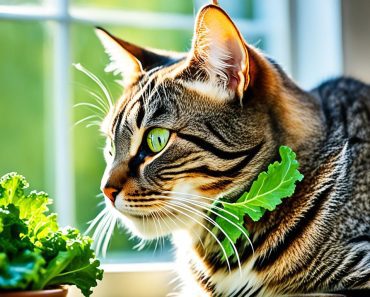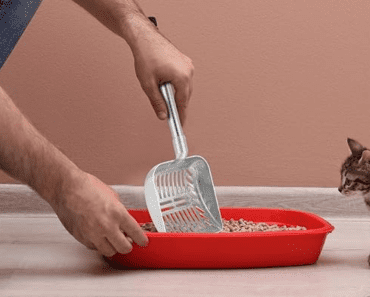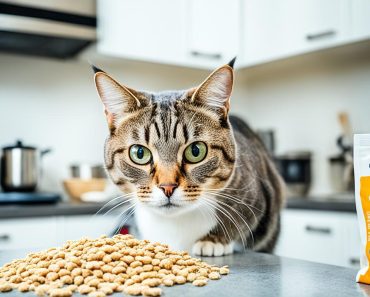I have always found cats to be curious creatures, often showing interest in the smallest things. However, when it comes to their diet, there are certain foods that can be harmful, and even fatal, to them. One such food is chocolate. While we humans may find it delicious and indulgent, chocolate is actually toxic to cats.
Chocolate contains two substances, caffeine and theobromine, which cats cannot metabolize safely. Even small amounts of chocolate can have serious consequences for our furry friends. It’s important to be aware of the dangers of cats eating chocolate and to understand the symptoms of chocolate poisoning in cats. This knowledge can help us take immediate action if our cats accidentally ingest chocolate.
Can Cats Eat Chocolate? It’s a big NO.
- Chocolate is toxic to cats due to the presence of caffeine and theobromine, which they cannot metabolize safely.
- Even small amounts of chocolate can be harmful and potentially fatal to cats.
- Symptoms of chocolate poisoning in cats include vomiting, diarrhea, loss of appetite, excessive thirst, rapid breathing, and muscle tremors.
- If your cat has ingested chocolate, it is important to contact your vet or an emergency vet immediately.
- Offering safe treats specifically formulated for cats is a better alternative to chocolate.
Why is Chocolate Unsafe for Cats?
Chocolate is highly dangerous for cats due to its toxic properties. The two main substances in chocolate that pose a threat to feline health are caffeine and theobromine. These compounds act as stimulants and can have severe adverse effects on a cat’s body.
Caffeine and theobromine can cause damage to a cat’s brain, heart, and muscles. They can also lead to increased heart rate, abnormal heart rhythm, and even seizures. Cats are especially vulnerable to the toxic effects of these substances due to their smaller size and weight.
It’s important to understand that even small amounts of chocolate can be harmful to cats. Therefore, it is crucial to ensure that cats do not have access to chocolate in any form.
How Much and What Kind of Chocolate is Harmful to Cats?
All types of chocolate, including white chocolate, milk chocolate, dark chocolate, baking chocolate, and cocoa powder, are harmful to cats to varying degrees. The toxicity level depends on the amount of cocoa in the chocolate. The higher the cocoa content, the more toxic it is. Even small amounts of chocolate can be harmful to cats.
It’s essential to be aware of the potential dangers associated with different types of chocolate. While white chocolate contains the least amount of cocoa and is generally considered the least toxic, it can still cause harm if consumed in large quantities. Milk chocolate has a higher cocoa content and poses a higher risk to cats. Dark chocolate and baking chocolate have even higher levels of cocoa, making them significantly more dangerous.
- White Chocolate: The lowest cocoa content of all chocolate varieties, but still contains cocoa butter, sugar, and other additives that can be harmful to cats if ingested in large amounts.
- Milk Chocolate: Contains a moderate amount of cocoa and poses a higher risk than white chocolate. This popular type of chocolate is often found in various treats, such as candies and cookies.
- Dark Chocolate: Contains a higher cocoa content and is therefore more toxic to cats. It is commonly used in gourmet chocolates and has a stronger flavor compared to milk chocolate.
- Baking Chocolate: Contains the highest level of cocoa and is the most dangerous chocolate variety for cats. It is unsweetened and primarily used in baking recipes. Even small amounts can cause severe toxicity.
- Cocoa Powder: Highly concentrated cocoa extract used in baking and cooking. It has a very high cocoa content and should be kept away from cats to prevent accidental ingestion.
Remember, regardless of the type of chocolate, even a small amount can potentially harm your feline companion. It’s important to keep all forms of chocolate away from cats and provide them with safe alternatives to ensure their well-being.

My Cat Ate Chocolate, What Do I Do?
If your cat has ingested chocolate, it is crucial to take immediate action to ensure their well-being. Here are the steps you should follow:
- Watch for Symptoms: Keep a close eye on your cat for any signs of chocolate poisoning. These symptoms may include vomiting, diarrhea, loss of appetite, excessive thirst, rapid breathing, and muscle tremors.
- Contact the Vet: As soon as you notice any symptoms or suspect that your cat has consumed chocolate, it is essential to get in touch with your vet or an emergency vet clinic immediately. They are the experts who can provide the necessary guidance and care.
- Induced Vomiting: Depending on the situation, your vet may instruct you to induce vomiting in your cat to remove the chocolate from their system. They will provide step-by-step instructions on how to do this safely.
- Tests and Treatments: Once you reach the vet, they will perform a thorough examination, which may include taking a urine sample, to assess the extent of the chocolate poisoning. They will then determine the appropriate treatment plan based on your cat’s condition.
- Administering IV Fluids: In severe cases of chocolate poisoning, your cat may require intravenous (IV) fluids to help flush out the toxins from their body and prevent dehydration.
- Treating Liver Disease: The consumption of chocolate can potentially lead to liver disease in cats. If necessary, your vet will provide treatments to address and manage any liver issues that may have resulted from the chocolate ingestion.
Remember, acting swiftly and seeking professional veterinary care is essential when your cat has eaten chocolate. By following these steps, you can ensure that your feline friend receives the necessary care and treatment to recover from chocolate poisoning.
How Do I Prevent My Cat From Eating Chocolate?
Preventing your cat from eating chocolate is crucial to their safety and well-being. Here are some effective measures you can take:
Cat-Proofing Your Home:
- Keep chocolate out of reach by storing it in high shelves or cabinets that your cat cannot access.
- Use airtight containers to store chocolate, ensuring there are no open bags or wrappers that could tempt your cat.
- Keep your pantry, fridge, and freezer well-organized so that chocolate is securely stored and not easily accessible to your curious feline friend.
Dispose of Chocolate Wrappers Promptly:
Dispose of chocolate wrappers promptly and securely. Your cat may be attracted to the scent and texture of the wrappers, so it’s important to prevent them from getting their paws on them.
By cat-proofing your home and taking these precautions, you can effectively prevent your cat from accidentally ingesting chocolate and ensure their safety.
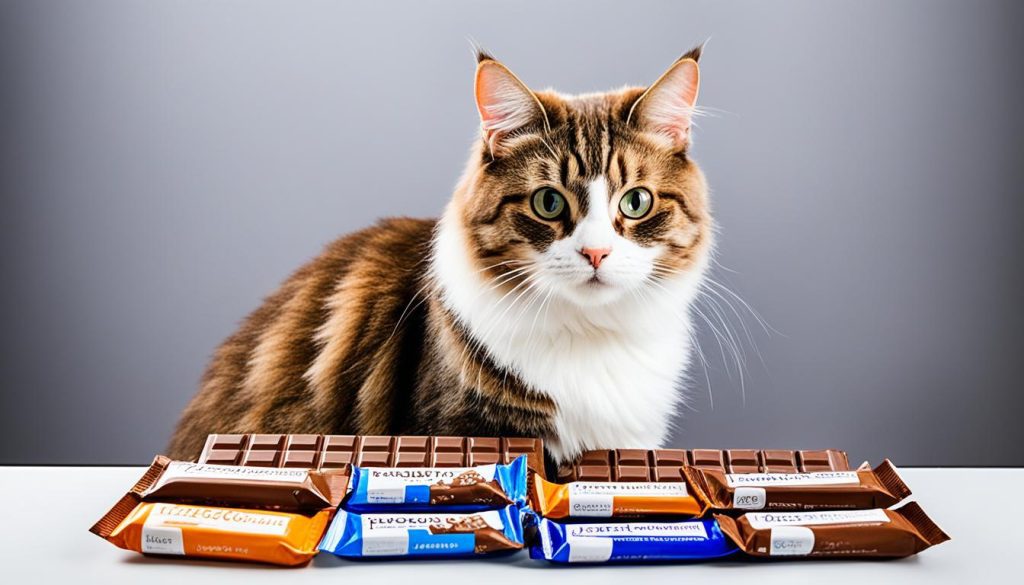
Alternatives to Chocolate for Cats
When it comes to treating our feline friends, it’s important to choose safe options that cater specifically to their needs. Instead of giving your cat chocolate, there are plenty of alternatives that are both delicious and feline-friendly.
Feline-Friendly Treats
Opt for safe treats that are specially formulated for cats. These treats not only taste great but are also designed to meet their nutritional requirements. Look for treats made with high-quality ingredients that provide essential nutrients for your cat’s overall health and well-being.
Health Benefits
Safe treats for cats offer various health benefits. They can help support your cat’s immune system, promote healthy digestion, and contribute to a shiny coat. Additionally, some treats are fortified with vitamins and minerals, providing an extra boost of nutrition for your furry friend.
Dental Care
Many feline-friendly treats are also designed to support dental health. These treats have a crunchy texture that helps to remove plaque and tartar buildup, reducing the risk of dental issues such as gum disease. By incorporating dental treats into your cat’s routine, you can contribute to their oral hygiene.
Bonding with Cats
Treating your cat is not only about fulfilling their nutritional needs but also a way to strengthen the bond between you and your feline companion. Spending quality time with your cat, offering treats as rewards during training or play sessions, can create positive associations and enhance your relationship.
Conclusion
It is evident that cats should never eat chocolate as it poses a significant risk to their health. Even small amounts can have serious consequences due to the toxicity of chocolate to cats. As responsible cat owners, it is crucial to be aware of the symptoms of chocolate poisoning in cats and take immediate action if your feline friend ingests any chocolate.
To ensure the safety and well-being of your cat, it is best to opt for safe treats that are specifically designed for feline consumption. These treats not only provide a satisfying taste and smell for cats but also offer essential health benefits and support dental care. By prioritizing the safety and providing a proper nutrition of your cat, you can keep your furry companion happy, healthy, and free from the dangers of chocolate poisoning.
Remember, prevention is key. Store chocolate in a cat-proof location, such as high shelves, airtight containers, or in the pantry, fridge, or freezer. Dispose of chocolate wrappers promptly to prevent your cat from accessing them. By taking these simple precautions and choosing the right treats, you can create a safe environment for your cat and avoid any accidental ingestion of chocolate.
Take care of your feline friend and prioritize their well-being. With the knowledge and understanding of the risks associated with chocolate, you can ensure a long and healthy life for your beloved cat. Always remember that their safety and health come first.

